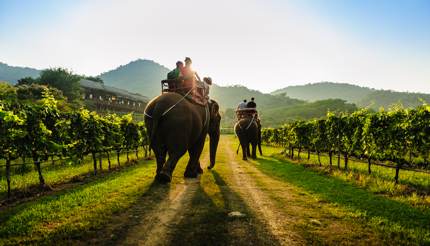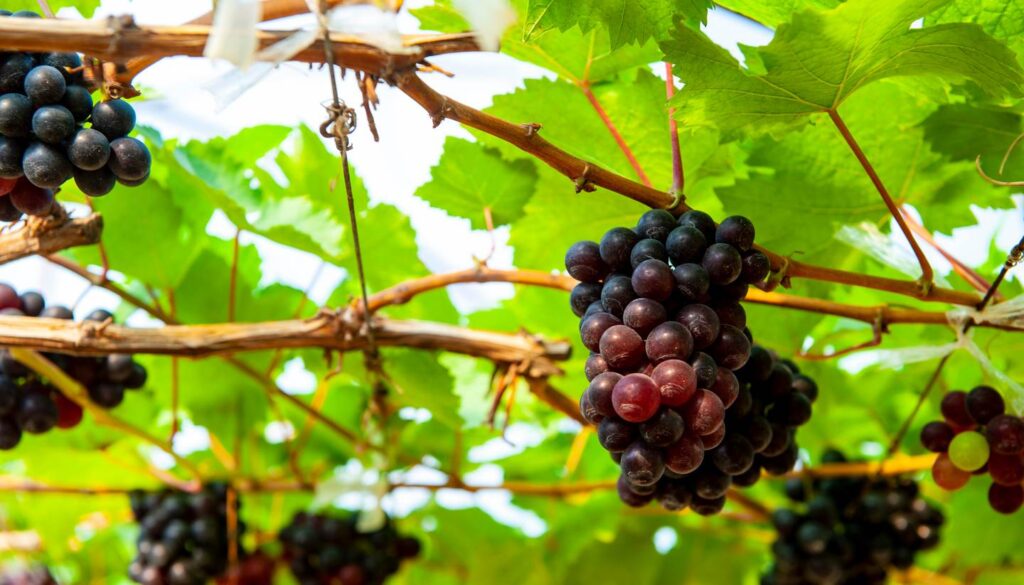[ad_1]
An achievement to be admired, we take you on a wonderful Thai wine journey to success.
Long associated with white sandy beaches, elephant rides and beautiful Instagram shots, Thailand is a popular tourist destination but has not emerged as a hotspot for wine. Yet nowadays, tourists are beginning to visit one of Thailand’s great vineyards.

A taste of history
In 1986, Charlemagne Yuvodhia began his quest to make Thai wine a leading player in Asian wine by founding Siam Winery. Buoyed by his success in branding Red Bull (founded by his father), Charlemagne aimed to increase appreciation of locally produced wine. First in Thailand, then globally.
Integrating wine into a drinking culture long established on beer and spirits was no easy task, so Charlemagne and his team set out to adapt wine flavors to the Thai palate and warmer climate. As a result, they launched SPY, a brand that focuses on refreshing mineral water with sparkling wine. Today, SPY is extremely popular in clubs and events (including various full moon parties) throughout Thailand.
Given further confidence from SPY’s success, Charlerm now felt ready to produce high-quality, undiluted wines. In 2001, he found a vineyard in Tab Quang in Khao Yai. The region is said to be suitable for winemaking due to its fertile soil and mild climatic conditions.
Inspired by this find, Charlemagne continued his search and found what he was looking for in a valley at Bam Khorak Chang, 35 km (22 mi) from the beautiful coast of Hua Hin. Now known as ‘Monsoon Valley’, the site soon became the principal vineyard for producing Monsoon Valley wines.
Monsoon Valley Wines
Monsoon Valley Wines was now born. As Charlemagne used these vineyards to produce and sell the finest Thai wine. Monsoon Valley The label
With over 350,000 bottles produced each year, ‘Monsoon Valley’ has become the face of Thai wine and became the first Thai winemaker to win “Brand of the Year” at the World Branding Awards 2017-18. Its premium range also won gold at the 2015 Decanter World Wine Awards.
Monsoon Valley’s ‘Classic’, ‘Premium’, ‘Signature’ and ‘Flagship’ ranges are produced largely from grapes grown in these three vineyards:
1. Hua Hin – Principle Location of Monsoon Valley Vineyards (2002)
- Located just two hours from Bangkok, this 110 hectare area is the largest vineyard managed by Monsoon Valley. The site used to be a sanctuary for wild elephants and has amazing views.
- Grapes grown here include Shiraz, Chenin Blanc, Sangiovese and Colombard.
- Monsoon Valley’s research facility is here, where brewers can develop new brewing techniques.
2. Tab Kwang in Khao Yai – Second largest vineyard (2001)
- Proudly billed as Charlemagne’s first vineyard, the soil here is ideal for producing red wine grapes such as Rondon, Shiraz, Dornfelder and Sangiovese.
3. Chiang Mai (2013)
- The northernmost of all the vineyards, the Chiang Mai site was established in 2013 and is an ideal experimental location.

Against the odds
Viticulture in Thailand is a revolutionary step in wine. Many experts doubted whether it would be possible to produce fine wine as close to the equator as in Thailand. Previously, it was generally assumed that regions 30 to 50 degrees latitude north or south of the equator (such as France, Italy, and Australia) were suitable for growing grapes suitable for wine production. were
Operating at the 13th degree latitude of the Northern Hemisphere, Thai Wine proudly pioneers the ‘New Latitude Wines’. Wines made in Kenya, Brazil and Indonesia join the list of wines made near the equator.
Not surprisingly, the Thai wine industry has had to overcome many challenges to produce wine in this part of the world.
Challenges facing Thai winemakers
An unstable climate.
Thailand’s tropical and often unstable climate forces Thai winemakers to target the dry season (typically September/October to March) for the 120 to 130 days the grapes typically ripen. are required for Other troubling problems caused by climate include:
- Heat and humidity – Compared to more traditional wine-growing regions, Thailand’s vineyards suffer from heat and humidity causing more fungi, insects and unpredictable diseases, as well as periods of sporadic bud burst.
- Tropical winds – which can damage the vines.
- Rain, lots of rain – a constant problem for wine growers. In Hua Hin on the Gulf of Thailand, for example, there are rains in September and October that can erode the soil and severely damage the vines.
Continuous daylight hours
In traditional wine-growing regions, grapes thrive in long and intermittent daylight hours, but in Thailand, daylight hours are much more consistent throughout the year, meaning grape vines can grow much longer. .
Increase in labor demand
The lack of dormancy period due to Thailand’s climate makes wine growing a laborious exercise. For example, vines need to be removed early in the rainy season to preserve them. This additional labor is also expensive and difficult to find because many manual laborers willing to take on the heavy workload are a thing of the past.
Unstable soil
This causes the grapes to ripen at different rates.
Thai brewers use innovative solutions.
The Thai wine industry is resilient. At Monsoon Valley, brewers constantly test innovative solutions including:
- He is working with the Geisenheim Research Center in Germany to find grape varieties that can thrive in Thailand’s volatile climate.
- They continue to experiment with grapes and climate conditions at their Hua Hin research facility.
- They plant grass to prevent soil erosion during the monsoon season.
- During the rainy season, water is collected in several ponds to irrigate the plants during the dry season.
- Elephants also help the workers by taking them to the vineyard.
A wonderful success story
Once written off as an impossible feat, Thailand now produces more than 1 million bottles of wine each year – about 350,000 of which are distributed under the Monsoon Valley label. Most of the major wineries competing with Monsoon Valley can be found around the rolling hills of Khao Yai, 130 km (81 mi) northeast of Bangkok. These include PB Valley Winery, Gran Monte Vineyard & Winery, J&J Vineyard, Village Farm & Winery, to name but a few. Tourists can delight in tours and wine tasting sessions at all these vineyards.

Popular grapes include:
- White wine – Chenin Blanc, White Malage, Colombard
- Red Wines – Shiraz, Pokadam, Sangiovese
- Rose – Colombard, White Shiraz
- Sparkling wine – Colombard
If you enjoyed this article, you may also be interested in:
This article was first published in August 2016 and updated in November 2019.
[ad_2]

